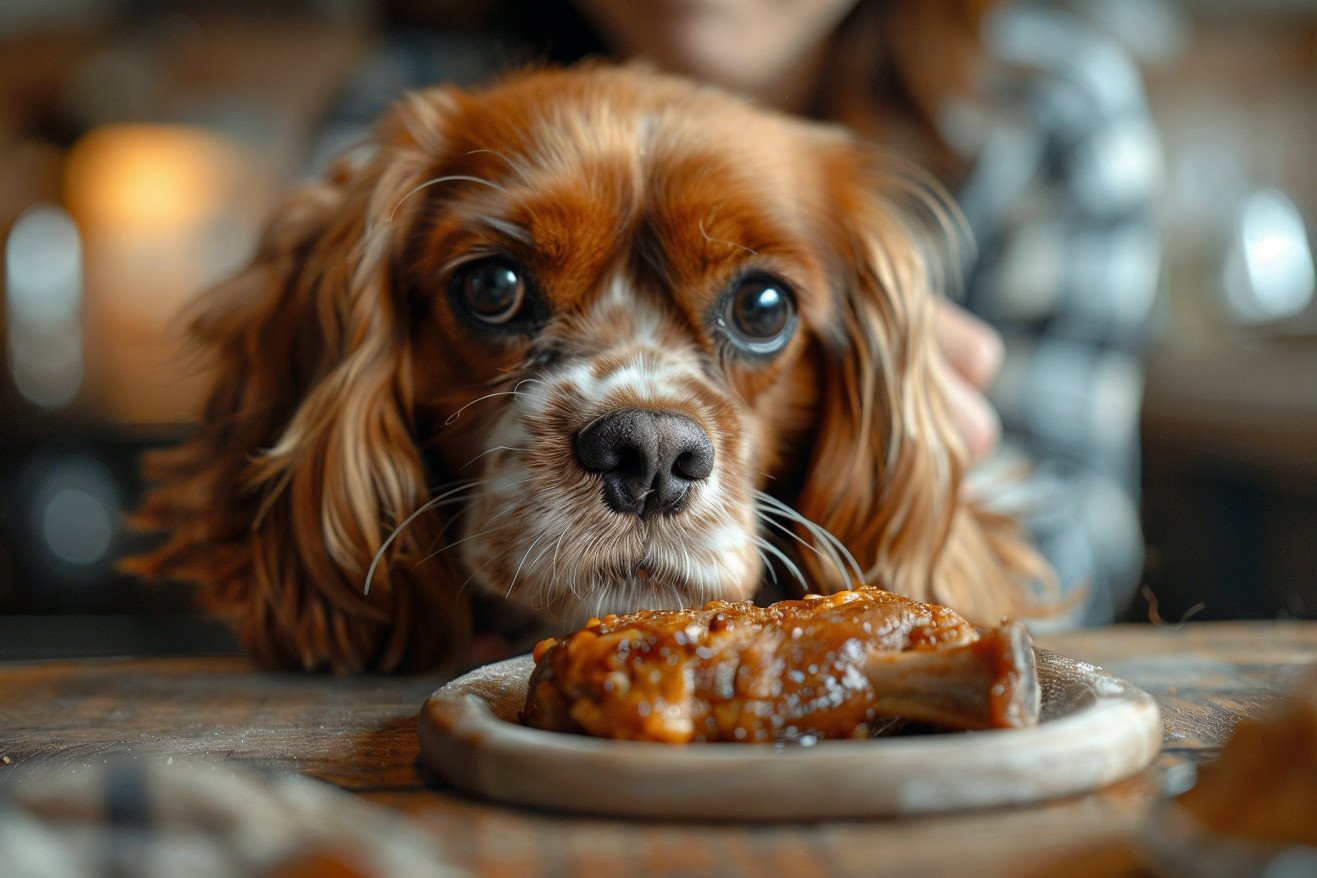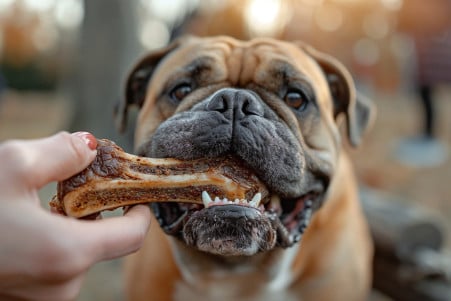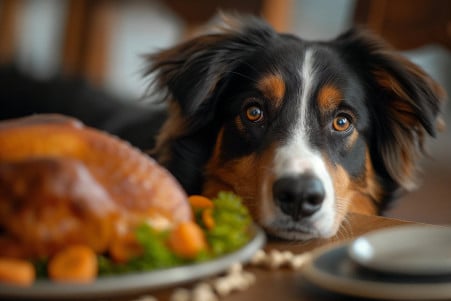Can Dogs Have Pork Chop Bones? Understanding the Risks
1 March 2024 • Updated 29 February 2024

While it may seem like a time-honored tradition to give your dog a bone, pork chop bones can be especially dangerous. Pork chop bones can splinter and cause a number of health issues, including choking, intestinal blockages, or internal damage. This is true whether the bones are cooked or raw, and because of this, veterinarians recommend other types of chews, like dental chews or toys.
This article will review veterinary health studies, animal nutrition research, and expert opinions to explain why these recommendations have been made. It will also discuss the digestive and nutritional impact of dogs eating bones and provide safe, healthy alternatives that will still allow your dog to engage in their natural chewing behavior. By learning the science behind these recommendations, you’ll be better equipped to make choices that will support your dog’s health and happiness.
Can dogs have pork chop bones?
Physical Risks of Pork Chop Bones for Dogs
There are a number of physical risks associated with pork chop bones as a dangerous dog treat. According to the American Kennel Club, bones can splinter and crack, which can cause choking, blockages in the digestive system, and even severe damage to the digestive tract.
Cooked bones are especially prone to splintering, but raw bones can also cause problems. When dogs swallow bone fragments, the sharp pieces can puncture or get stuck in their esophagus, intestines, and other organs.
If your dog has eaten a pork chop bone, it’s important to watch them for signs of distress. These can include vomiting, drooling, diarrhea, and a sudden loss of appetite, says Dr. Joanna Woodnutt. These symptoms could be a sign of a blockage or internal injury.
If you notice any symptoms or behaviors that worry you after your dog has eaten a bone, take them to the vet right away. Waiting to get treatment can make the problem worse and may require more invasive treatments, including surgery. By monitoring your dog closely after they’ve been around bones, you can help prevent potential medical emergencies and ensure that they’re safe and comfortable.
Canine Digestion and Bone Ingestion
When we look at the canine digestive system, we see that it’s quite different from the human digestive system, and it also explains why there are so many risks associated with dogs eating bones.
Dogs have a much shorter gastrointestinal tract and a much more acidic stomach, which is great for breaking down protein but not so great for dealing with the hard, non-digestible nature of a pork chop bone.
According to Vet’s All Natural, a dog’s gastric pH is much lower when they’re on a raw meat diet, which helps them break down raw meat and bones and also helps them kill off bacteria that could be harmful. However, when dogs are fed a diet that’s high in carbs and low in meat protein, the gastric pH can become more alkaline, which makes it harder to break down bones and increases the risk of an obstruction.
A study published in the Journal of Veterinary Internal Medicine and discussed on PubMed Central found that dogs that ingested bones were most likely to develop esophageal and gastric bone foreign bodies (E-bFBs and G-bFBs).
Most of these cases required medical treatment, and the most common treatment was endoscopic removal for gastric bones.
However, some foreign bodies were managed conservatively and allowed to dissolve on their own, but this process also had its own risks.
This study shows that it’s important to make sure that a dog’s diet is set up to maintain the right level of gastric acidity to break down bones while also making sure that we’re aware of the risks that bones can pose. This means that as pet owners, we need to make sure that we’re feeding our pets a diet that supports their digestive health and that we’re not giving them anything that could be harmful.
So, what are some safe and healthy alternatives that can meet a dog’s nutritional needs?
Nutritional Needs and Safer Chew Options for Dogs
Pet parents need to make sure their dog’s diet is balanced and complete, which means it meets the nutritional standards set by the Association of American Feed Control Officials (AAFCO), including proteins, fats, carbohydrates, vitamins, and minerals, according to the Clinical Nutrition Service at Cummings School.
While bones can provide some nutritional benefits, such as calcium and phosphorus, the meat, fat, and connective tissues on the bones are the most important parts, according to PetMD.
To make sure dogs get the nutrition they require without the dangers of pork chop bones, pet parents can look to safer alternatives.
There are companies that make dental chews that are formulated to be easily digestible and help support oral health, and they also make chew toys out of non-toxic materials that can stand up to heavy chewing.
Pet parents can make sure these alternatives are part of their dog’s diet by choosing products that are right for their dog’s size and dietary restrictions and by keeping an eye on their health and how much they consume, according to PetMD.
In doing so, pet parents can avoid the health risks of pork chop bones while still meeting their dog’s natural chewing needs, which can help support their overall health and well-being.
Mental Health Benefits of Chewing for Dogs
Chewing is more than just a hobby for dogs; it’s an instinctual behavior that has real mental health implications. A study by Flint et al. in Animals found that long-lasting chews can create positive emotional states in dogs, especially when they are socially isolated. This shows that chewing can help improve a dog’s mental health by helping to stave off negative feelings like boredom and anxiety.
Given this instinctual need to chew, it’s important to provide safe alternatives to dangerous pork chop bones. The Woof Club recommends natural chew bones or 100% natural chews as safer options, and these can even help with dental health.
However, these should be introduced with supervision, and pet owners should watch to see how their dog reacts to make sure they are both enjoying and being safe with the chews. By providing dogs with the right items that cater to their natural chewing behavior, you can help ensure that their mental health and physical well-being are in balance.
In addition to the mental health benefits, the ASPCA points out that the right chew toys and treats can also help prevent destructive behaviors. By providing the right chews, you are helping dogs fulfill a natural need, and this can help them avoid destructive behaviors. This naturally leads to a discussion of how to choose the best and safest chew toys for your dog.
How to Choose Chew Toys That Are Safe and Fun for Your Dog
When choosing chew toys for your dog, it’s important to think about things like size, durability, and materials to make sure they are safe. According to an article by Preventive Vet, you should also think about your dog’s chewsonality to find the right toy for them.
The size of the toy is important because if it’s too small, it could be a choking hazard, and durability is important so that the toy can stand up to your dog’s chewing. The materials the toy is made of should be non-toxic and strong.
Veterinarians such as Dr. Turner recommend toys like the KONG Classic, which is a rubber chew toy that is known for its safety and durability. Similarly, the Qwizl treat toy by West Paw is considered to be durable and safe for even the most aggressive chewers.
It’s also important to supervise your dog while they play to make sure that the toys they are using are still safe and intact. By checking toys after playtime, you can make sure that they are not at risk of being swallowed or causing other problems.
For example, if a chew toy is broken or parts of it have been swallowed, it should be taken away from your dog, and you should consult your vet. Chew toys should also be cleaned and checked regularly to make sure that they are not becoming a hazard.
As a dog owner, it’s your responsibility to provide your pet with safe, fun toys that meet their needs and keep them out of harm’s way. To this end, it’s important to make sure that we are making informed choices about the toys we give our pets to play with.
Final Thoughts on Feeding Dogs Pork Chop Bones
As we’ve learned, the potential risks of feeding dogs pork chop bones are many. The threat of choking, blockages, gut injuries, and perforations means that pork chop bones can be a real danger to our dogs. Veterinary research and professionals are in agreement that dogs should not be given pork chop bones due to the serious and sometimes fatal risks.
Knowing how a dog’s digestive system works, what they need nutritionally, and what they need psychologically shows why it’s so important to make sure that dogs have safe and healthy things to chew on. By providing dogs with toys and treats that are made for them, we can make sure that they can satisfy their natural need to chew while also keeping them safe and healthy.
Good pet parents are responsible for their pets’ well-being, and that includes keeping up with the latest information about pet health and safety. Our dogs depend on us to keep them safe and healthy by making sure they have safe things to chew on and by not giving them things that are dangerous, like pork chop bones.
By making sure that we’re informed and taking care of our dogs, we can help them live long, healthy, and happy lives.


